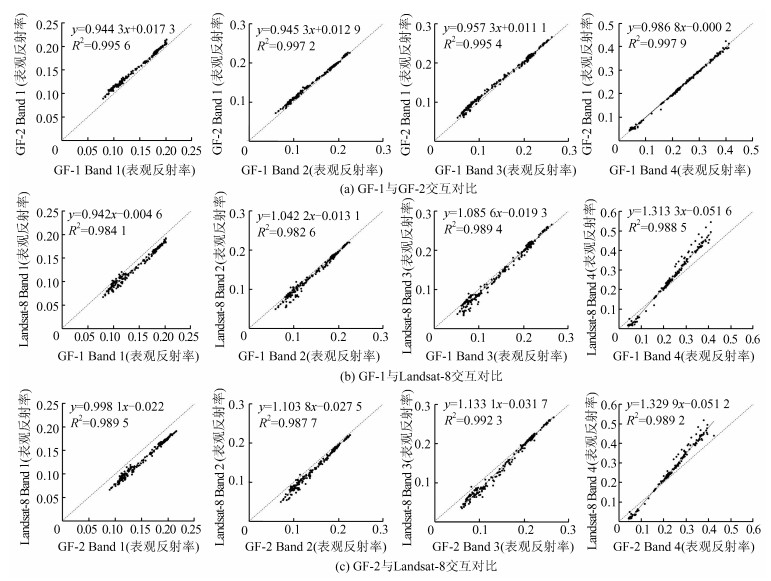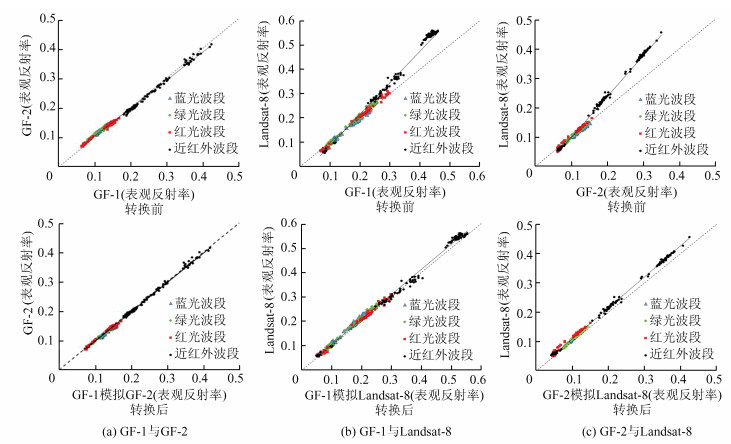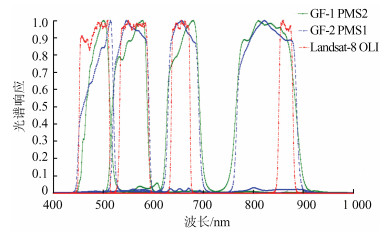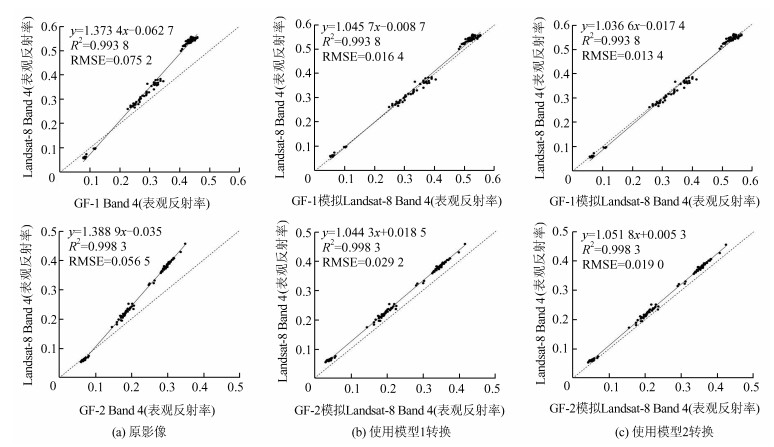-
摘要: 基于两组敦煌定标场的GF-1 PMS2、GF-2 PMS1与Landsat-8 OLI(operational land imager)同步影像,对3种传感器之间表观反射率数据的一致性进行交互对比。结果表明,两颗国产高分卫星的表观反射率数据具有很高的一致性,但它们与Landsat-8数据之间存在着一定的差异,其中尤以近红外波段的差异最为明显。在可见光波段,3种传感器的信号强度关系为:GF-2 PMS1 > GF-1 PMS2 > Landsat-8 OLI,在近红外波段的关系为:Landsat-8 OLI > GF-1 PMS2 > GF-2 PMS1。试验结果表明,所提出的数据转换模型能够有效地降低两种国产高分卫星传感器与Landsat-8 OLI在近红外波段的明显差异,且当选择与被转换影像地物比例一致性较高的模型进行转换时,转换精度能够进一步提高。Abstract: This paper aims at an analysis on the consistency of the top of atmosphere (TOA) reflectance among GF-1 PMS2, GF-2 PMS1 and Landsat-8 operational land imager(OLI) sensor data based on two synchronous image pairs. The result shows that TOA reflectance of GF-1 PMS2 and GF-2 PMS1 sensors has a high degree of agreement. Nevertheless, this paper also finds that TOA reflectance of either GF-1 PMS2 or GF-2 PMS1 data is less consistent with that of Landsat-8 OLI data, especially in the near-infrared band. In general, the rank of TOA reflectance in the blue, green and red bands of three sensors data is as follows:GF-2 PMS1 > GF-1 PMS2 > Landsat-8 OLI, while the relationship in the near-infrared band is:Landsat-8 OLI > GF-1 PMS2 > GF-2 PMS1. The coversion models among the three sensors data were obtained through regression analysis. The validation shows that the conversion equations can significantly reduce the difference in the near-infrared band among the three sensors. It is also found that when the image to be converted has similar land cover types and proportions with the image on which the conversion model was developed, the conversion accuracy can be improve.
-
Keywords:
- multispectral data /
- GF-1 /
- GF-2 /
- Landsat-8 /
- top of atmosphere reflectance /
- cross-comparison
-
2018年4月,Nature刊出新闻[1],美国政府正在考虑对长期免费使用的Landsat系列卫星数据重新采用收费政策。若美国政府一旦采用该政策,我国遥感领域的研究必将更多地依赖于国产卫星数据,因此提高国产卫星影像数据的精度就成为亟需解决的问题。
多源遥感卫星传感器数据之间的交互对比是辐射定标的一种重要方法,迄今为止,国内外学者已进行了大量的相关研究[2-3],有关我国新型传感器多光谱数据的交互对比研究也陆续展开[4-6]。GF-1和GF-2卫星的观测数据是我国现阶段主要应用的高分影像数据,但目前关于二者获取的信号是否准确尚未有研究。Landsat-8 OLI(operational land imager)具有较高的定标精度,各方面性能已经趋于完善[7],因此,本文将GF-1 PMS2和GF-2 PMS1的多光谱数据与该数据进行了交互对比(下文简称为GF-1、GF-2、Landsat-8),研究三者之间表观反射率数据的一致性,并提出相应的表观反射率数据的转换模型。本研究将有利于认识GF-1、GF-2数据与Landsat-8数据的差距,并实现它们与Landsat-8数据之间的相互转换。
1 传感器特征
GF-1和GF-2作为同系列高分卫星虽然具有许多相似之处,但它们在波段设置、波长范围、空间分辨率等方面与Landsat-8均有不同,因此本文选取三者的共有波段进行比较,GF-1、GF-2和Landsat-8卫星的参数如表 1所示。
表 1 GF-1、GF-2和Landsat-8卫星参数Table 1. Parameters of GF-1, GF-2 and Landsat-8 Sensors卫星参数 GF-1 GF-2 Landsat-8 蓝光波段/μm 0.45~0.52 0.45~0.52 0.45~0.51 绿光波段/μm 0.52~0.59 0.52~0.59 0.53~0.59 红光波段/μm 0.63~0.69 0.63~0.69 0.64~0.67 近红外波段/μm 0.77~0.89 0.77~0.89 0.85~0.88 空间分辨率/m 8 4 30 辐射分辨率/bit 10 10 12 重访周期/d 4 4 16 2 试验方法
2.1 数据源与研究区
本文的试验数据选自我国用于卫星数据定标的敦煌定标场。敦煌定标场是GF-1、GF-2卫星传感器的辐射定标场,场地内大气干燥、清洁,表面光学均匀性好,反射比变化小[8],选择其同步影像进行交互对比能够保证试验数据的质量与精度的可靠性。本文在敦煌定标场共找到GF-1、GF-2与Landsat-8的两组(6幅)同步影像对(见表 2),研究区的地表覆盖类型以裸土与植被为主,兼有少量水体。两组同步影像的日照和大气条件良好,基本无云,同时考虑到PMS是可以进行侧摆的传感器,而OLI是无法侧摆、星下成像的传感器,因此所选用的GF-1、GF-2影像均为星下点成像,相机侧摆角为0°,确保了不同传感器对地物观测的一致性。此外,本文另选取了位于湖北仙桃、新疆克拉玛依和湖北荆门的3对同步影像作为验证影像(见图 1、表 2)。
表 2 同步影像参数Table 2. Parameters of Synchronous Image Pairs成像地点 传感器 日期 时间 太阳天顶角/(°) 太阳方位角/(°) 敦煌定标场南部 GF-1 PMS2 2016-08-26 11:05:14 30.89 160.92 GF-2 PMS1 10:48:44 32.12 153.44 Landsat-8 OLI 10:20:11 35.02 143.51 敦煌定标场西南部 GF-1 PMS2 2016-08-26 11:05:28 30.15 160.15 GF-2 PMS1 10:48:59 31.39 152.49 Landsat-8 OLI 10:20:35 34.05 141.72 湖北仙桃 GF-1 PMS2 2016-06-14 11:48:31 10.87 129.07 GF-2 PMS1 11:31:42 13.91 117.92 新疆克拉玛依 GF-1 PMS2 2015-08-25 13:46:43 34.90 164.17 Landsat-8 OLI 13:01:53 37.63 147.76 湖北荆门 GF-2 PMS2 2017-03-27 11:39:17 31.31 152.14 Landsat-8 OLI 11:02:05 35.53 136.63 2.2 辐射校正
本文采用将影像灰度值(digital number,DN)转换为表观反射率的方法对影像进行辐射校正,由于所选用的同步影像对的过空时间相差不大,受大气影响很小,因此采用日照差异校正模型(illumination correction model,ICM)来计算表观反射率[9]。ICM的公式为[10]:
$${L_{\lambda {\rm{}}}} = {\rm{Gain}} \cdot {\rm{DN}} + {\rm{Offset}}$$ (1) $${\rho _{\lambda {\rm{}}}} = {\rm{ \mathit{ π} }}{L_\lambda }{d^2}/\left( {{\rm{ESU}}{{\rm{N}}_\lambda } \cdot {\rm{cos}}{\theta _s}} \right)$$ (2) 式中,Lλ是传感器处的辐亮度;ρλ为传感器处的表观反射率;Gain和Offset分别是传感器定标的增益值和偏移值;d为日-地天文单位距离;ESUNλ是大气顶部的平均太阳辐照度;θs是成像时的太阳天顶角。
由于Landsat-8卫星改进后,在表观反射率反演方面与以往Landsat系列有较大的差异,减少了d、ESUNλ等参数的计算,因此可以直接采用以下公式得到传感器处的表观反射率[11]:
$${\rho _{\lambda {\rm{}}}} = \left( {{M_\rho } \cdot {Q_{cal}} + {A_\rho }} \right)/{\rm{cos}}{\theta _s}$$ (3) 式中,Qcal为影像的DN值;Mρ为波段λ的反射率调整因子;Aρ为波段λ的反射率调整参数;θs为成像时的太阳天顶角,它们都可以从影像头文件中获得。
2.3 样区的选择
由于GF-1、GF-2和Landsat-8传感器的空间分辨率不同,因此本文采用样区光谱均值比较法进行对比[12]。在每组试验影像对中分别选取140个位置和范围相同的均质感兴趣区域(region of interest,ROI),包含低、中、高亮度样区与植被样区,然后以各样区的光谱均值来进行对比。所选样区地形平坦,面积适宜,具有同质性,且有一定的波长覆盖范围,每个样区像元数在数十到数百个之间。
3 结果与分析
3.1 表观反射率的一致性
为了使试验结果更具有代表性,本文将两个试验区共280个ROI样区合并进行分析。按照§2方法对GF-1与GF-2、GF-1与Landsat-8、GF-2与Landsat-8 3组传感器进行交互对比(见图 2、表 3),不同传感器数据之间的偏差程度主要通过均方根误差(root mean square error,RMSE)来衡量[13]。
表 3 不同传感器表观反射率数据对比Table 3. Comparison of Top of Atmosphere Reflectance Data Among GF-1, GF-2 and Landsat-8波段 表观反射率均值 RMSE GF-1 GF-2 Landsat-8 GF-1与GF-2 GF-1与Landsat-8 GF-2与Landsat-8 蓝光 0.149 0 0.158 0 0.135 7 0.009 5 0.014 2 0.022 5 绿光 0.150 6 0.155 2 0.143 9 0.005 7 0.009 4 0.013 3 红光 0.157 8 0.162 1 0.152 0 0.006 5 0.010 7 0.014 3 近红外 0.210 2 0.207 2 0.224 4 0.005 3 0.035 7 0.037 8 由图 2及表 3可以看出,3组对比传感器的R2值均大于0.98,表明它们之间各对应波段都具有很强的相关性(方程通过p < 0.001的显著性检验,且单尾、双尾均小于0.001)。GF-1与GF-2回归线靠近1:1线,且RMSE均小于0.01,二者的表观反射率均值相差也不大;而GF-1、GF-2与Landsat-8之间的回归趋势线则不同程度地偏离了1:1线,其均值有不同程度的差距。从表 3可以看出,GF-1、GF-2与Landsat-8之间的RMSE在各个波段都要高于GF-1与GF-2之间的值,在近红外波段表现得尤为明显。上述分析表明,GF-1与GF-2的数据有很高的一致性,但它们与Landsat-8数据之间则存在着一定的差异,且在近红外波段的差异最大。
从图 2可以看出,GF-1与GF-2在可见光波段的回归线均位于1:1线上方,在近红外波段则几乎紧贴1:1线,表明GF-2的信号在蓝、绿、红波段总体上高于GF-1,在近红外波段二者差距很小,GF-2的信号略微低于GF-1。两颗国产卫星与Landsat-8的回归线趋势基本一致,可见光波段的回归线均位于1:1线下方,而近红外波段的回归线则大部分位于1:1线上方。由此可见,两种国产高分卫星在可见光波段的信号均强于Landsat-8,在近红外波段大部分的反射率范围内,却弱于Landsat-8。
总结上述关系可以发现,在可见光3个波段,3种传感器的信号强度关系为:GF-2 > GF-1 > Landsat-8,在近红外波段的信号强度关系为:Landsat-8 > GF-1 > GF-2。
3.2 转换模型验证
本文利用未参与试验的仙桃、克拉玛依、荆门3对影像来验证图 2中所求得的各对应传感器的关系转换模型。首先在3对验证影像上同样严格按照前述样区选取原则各选取100个样区,然后利用图 2的关系方程进行表观反射率数据的转换(见表 4、图 3)。
表 4 3对试验影像数据转换前后结果对比Table 4. Comparison of GF-1, GF-2 and Landsat-8 Images Before and After Conversion影像对 Band 1 Band 2 Band 3 Band 4 GF-1与GF-2 转换前 0.006 5 0.005 9 0.004 9 0.008 3 转换后 0.004 9 0.003 0 0.004 8 0.005 8 GF-1与Landsat-8 转换前 0.003 7 0.007 1 0.013 3 0.075 2 转换后 0.013 8 0.010 1 0.007 7 0.016 4 GF-2与Landsat-8 转换前 0.003 0 0.003 1 0.007 5 0.056 5 转换后 0.019 6 0.015 5 0.018 9 0.029 2 图 3为3幅验证影像转换前后各波段表观反射率的散点图,以及将所有波段反射率数据进行合并后得到的总回归趋势线。从图 3(a)和表 4可以看出,GF-1通过转换方程模拟成GF-2数据后,各波段的散点以及总回归线更贴近1:1线,RMSE也进一步下降,其中近红外波段的降幅达30.12%。
GF-1、GF-2与Landsat-8转换前的总回归线都明显偏离1:1线(图 3(b)、图 3(c))。通过将GF-1、GF-2模拟转换成Landsat-8数据后,二者的总回归线与1:1线的偏离程度明显减小。但从表 4来看,经过模拟转换后,GF-1的前2个波段以及GF-2的前3个波段的RMSE反而有所增大,但二者在近红外波段的RMSE却有大幅下降。模拟转换后,GF-1与Landsat-8之间的RMSE降幅可达78.19%,而GF-2的RMSE降幅也能达到48.31%。
以上分析表明,在使用图 2中的转换关系式进行转换后,能够进一步降低GF-1与GF-2数据之间的差异,但由于GF-1与GF-2的数据原本就很接近(RMSE < 0.01),因此降幅并不大。对于GF-1、GF-2与Landsat-8数据的关系而言,利用敦煌定标场得出的关系方程进行转换后,发现二者在可见光波段会出现RMSE增大的现象,因此在二者差距不明显时(RMSE < 0.01),可不必进行转换,否则有可能出现“矫枉过正”的情况。但它们在近红外波段的差距经过转换后明显减小,说明如果将GF卫星数据和Landsat-8数据协同使用时,必须进行近红外波段数据之间的转换。图 3(b)、图 3(c)中,GF-1、GF-2经转换后与1:1线的接近也是得益于近红外波段的偏离显著的减少。
4 讨论
4.1 表观反射率差异原因分析
§3分析结果表明,GF-1、GF-2与Landsat-8各波段的表观反射率存在着一定的差异。虽然不同卫星传感器成像时的大气条件、观测角度及地表形态差异等因素容易引起表观反射率的系统性偏差[14],但本文选取的同步影像对已最大程度地避免了此类差异。为此,本文对引起3种传感器表观反射率差异的主要原因进行了分析。
1)光谱响应函数的不同。图 4为3种卫星传感器对应波段的光谱响应函数曲线,可以看出GF-1与GF-2的光谱响应函数较为相似,因此它们的表观反射率一致性较高。就其4个波段而言,GF-1与GF-2在近红外波段的光谱响应函数起伏差异最小,光谱响应范围也大致相同,因此二者在近红外波段的反射率也最接近。但GF-1、GF-2和Landsat-8各波段的光谱响应函数曲线形状与光谱范围都存在着明显差异, 特别是近红外波段的波谱范围差异显著,Landsat-8近红外波段的光谱范围明显窄于两颗GF卫星。虽然Landsat-8卫星在设计时收窄了原Landsat-7近红外波段的光谱范围,以去除0.825 μm处的水汽影响(见表 1)[15],但国产高分卫星在近红外波段仍然采用0.77~0.89 μm的波谱范围,因此其反射会受到0.825 μm处的水汽吸收影响,导致它们在近红外波段的信号弱于Landsat-8。
2)空间分辨率的影响。GF-1的空间分辨率为8 m,GF-2为4 m,Landsat-8为30 m,由于不同的空间分辨率对地物细节的分辨能力不同,因此会造成不同分辨率传感器之间表观反射率的差异。为了考察这一现象,在敦煌定标场西南部的影像中随机选取一块面积为1 800 m2的裸土区域(见图 5),分别统计该区域内GF-1、GF-2和Landsat-8的表观反射率的动态范围(最大值-最小值) (见表 5)。从表 5可以看出,在1 800 m2的面积内,30 m分辨率的Landsat-8只有2个像元,因此其各波段的动态范围几乎都为0;8 m分辨率的GF-1的像元数有28个,其各波段的动态范围为0~0.003,而分辨率最高的GF-2具有112个像元,其各波段的动态范围为0.003~0.007。显然,影像的空间分辨率越高,就越容易捕捉到细小地物的光谱信息,因此在同一区域内表观反射率的动态范围就会产生差异。这一分析表明空间分辨率的差异也会对各传感器的表观反射率产生影响。
表 5 空间分辨率的差异对传感器表观反射率的影响Table 5. Impact of the Difference of Spatial Resolution on Top of Atmosphere Reflectance波段 GF-1 (像元数:28) GF-2 (像元数:112) Landsat-8(像元数:2) 最小值 最大值 动态范围 最小值 最大值 动态范围 最小值 最大值 动态范围 蓝光 0.191 0.191 0 0.198 0.201 0.003 0.175 0.175 0 绿光 0.194 0.196 0.002 0.196 0.200 0.004 0.190 0.190 0 红光 0.215 0.218 0.003 0.213 0.219 0.006 0.215 0.215 0 近红外 0.222 0.224 0.002 0.214 0.221 0.007 0.233 0.234 0.001 3)过空时间差异的影响。虽然本次研究选用的都是同日影像对,但它们之间的过空时间仍有一定差异,这期间如有大气状况的改变, 也会对交互对比的结果产生一定的影响[16]。此外,由于太阳天顶角会随着卫星过空时间的不同而发生改变,从而也会对表观反射率的反演结果产生影响。下面以敦煌定标场西南部同步影像对的
蓝光和近红外波段为例进行试验。GF-1、GF-2与Landsat-8影像过空时间分别为11:05:28、10:48:59和10:20:35,对应的太阳天顶角分别为30.15°、31.39°和34.05°。每幅影像除了采用自己的天顶角利用式(2)或式(3)计算表观反射率外,还同时采用了其他两种传感器的天顶角进行计算(见表 6)。从表 6可以看出,3幅影像卫星过空时间的差异所造成的天顶角差异会对其表观反射率的反演产生一定的影响,GF-1与GF-2由于过空时间接近,天顶角不同引起的差异很小,但二者与Landsat-8的差异因间隔时间较长而略大。
表 6 过空时间差异对蓝光和近红外波段表观反射率的影响Table 6. Impact of the Difference of Satellite Overpass Time on Top of Atmosphere Reflectance卫星影像 太阳天顶角θs/(°) 过空时间差异/min 蓝光波段表观反射率 近红外波段表观反射率 均值 差异/% 均值 差异/% GF-1 30.15 — 0.181 — 0.243 — 31.39 17 0.183 1.10 0.246 1.23 34.05 45 0.189 4.42 0.254 4.53 GF-2 31.39 — 0.186 — 0.240 — 30.15 17 0.188 1.08 0.236 -1.67 34.05 28 0.194 4.30 0.247 2.92 Landsat-8 34.05 — 0.161 — 0.260 — 30.15 45 0.166 3.11 0.249 -4.32 31.39 28 0.159 -1.24 0.252 -3.08 注:粗体字为GF-1、GF-2、Landsat-8影像自身的太阳天顶角及其计算的影像表观反射率均值 4.2 地物类型对转换模型的影响
目前,多数与传感器交互对比相关的研究在进行不同传感器数据的模拟转换时仅局限于单一转换模型。考虑到不同地表类型的反射特性对影像整体的表观反射率有较大的影响,本文认为在进行数据转换时,若能选择与影像地物类型与比例一致的转换模型,将有利于提升转换的精度。由于GF-1、GF-2与Landsat-8的近红外波段存在着显著的差距,因此本文主要以GF-1、GF-2与Landsat-8影像的近红外波段为例进行对比。
前述的克拉玛依与荆门验证影像的100个样区中包含有45%植被样区、45%裸土样区和5%水体样区,为此,在试验影像上选取同样地物比例的样区构建转换模型(简称模型2,方程通过p < 0.001的显著性检验,且单尾、双尾均小于0.001),并按照上文所述方法进行数据转换,将所得结果与图 3中的结果(简称模型1)进行对比,结果如图 6所示。
从图 6(b)、图 6(c)来看,经两种模型转换后,GF-1、GF-2与Landsat-8表观反射率散点均更加靠近1:1线,RMSE也有明显下降。使用模型1转换后,GF-1、GF-2与Landsat-8传感器之间的RMSE降幅分别为78.19%与48.31%,而使用模型2转换后,其RMSE的降幅分别提高到82.18%与66.37%,这表明虽然两种转换模型均能提高两颗国产卫星与Landsat-8近红外波段的一致性,但当选择与需要转换的影像地物类型和比例相同的模型进行转换时,拟合精度还能得到进一步提升。因此,在后续研究中,若需对GF-1、GF-2与Landsat-8的数据进行转换,应尽量使建立转换模型的地物类别和比例与被转换影像的地物类别和比例大致相同,才能更有效地提升转换精度。
5 结语
本文通过对GF-1、GF-2与Landsat-8的交互对比,探究了3种传感器表观反射率之间的一致性,结论如下:
1)GF-1与GF-2的数据有较高的一致性,但它们与Landsat-8的数据之间仍然存在着一定的差异,且以GF-2与Landsat-8的差异更明显。两种国产高分卫星在蓝、绿、红波段的信号均强于Landsat-8,但在近红外波段大部分的反射率范围内,Landsat-8的信号都比国产高分卫星强。在可见光波段,3种传感器的信号强度关系为:GF-2 > GF-1 > Landsat-8,在近红外波段的信号强度关系为:Landsat-8 > GF-1 > GF-2。
2)两颗国产高分卫星与Landsat-8各波段的表观反射率的偏差主要是光谱响应函数、空间分辨率以及传感器过空时间的不同引起的。Landsat-8卫星与两颗国产高分卫星表观反射率的差异在近红外波段最为显著,Landsat-8的信号明显高于GF-1与GF-2。这主要是由于Landsat-8在设计时收窄了原近红外波段的光谱范围,去除了0.825 μm处的水汽吸收影响,而国产卫星迄今为止仍维持着0.77~0.89 μm的较宽的光谱范围,其信号因受到0.825 μm处水汽吸收影响而表现出明显的低谷。鉴于此,本文建议今后国产卫星在研发设计时能够对考虑近红外波段的光谱范围进行调整,以缩小与国际上定标精度较高的卫星之间的信号差距。
3)本文基于敦煌定标场影像获得了GF-1、GF-2与Landsat-8多光谱数据之间的转换模型,并将它们应用在3幅不同地区和地类的试验影像上。试验结果表明,当不同传感器的数据差距较大时,转换方程可以有效缩小它们之间的差距。但当差距较小时(如RMSE < 0.01), 则缩小的差距不明显,甚至会出现“矫枉过正”的现象,因此不需要进行校正。需要指出的是,本文所获得的转换模型并不属于通用模型,仅适用于传感器无侧摆、过空时间相同或相近、大气状况良好以及地类及其比例与本次试验相近的影像。
-
表 1 GF-1、GF-2和Landsat-8卫星参数
Table 1 Parameters of GF-1, GF-2 and Landsat-8 Sensors
卫星参数 GF-1 GF-2 Landsat-8 蓝光波段/μm 0.45~0.52 0.45~0.52 0.45~0.51 绿光波段/μm 0.52~0.59 0.52~0.59 0.53~0.59 红光波段/μm 0.63~0.69 0.63~0.69 0.64~0.67 近红外波段/μm 0.77~0.89 0.77~0.89 0.85~0.88 空间分辨率/m 8 4 30 辐射分辨率/bit 10 10 12 重访周期/d 4 4 16 表 2 同步影像参数
Table 2 Parameters of Synchronous Image Pairs
成像地点 传感器 日期 时间 太阳天顶角/(°) 太阳方位角/(°) 敦煌定标场南部 GF-1 PMS2 2016-08-26 11:05:14 30.89 160.92 GF-2 PMS1 10:48:44 32.12 153.44 Landsat-8 OLI 10:20:11 35.02 143.51 敦煌定标场西南部 GF-1 PMS2 2016-08-26 11:05:28 30.15 160.15 GF-2 PMS1 10:48:59 31.39 152.49 Landsat-8 OLI 10:20:35 34.05 141.72 湖北仙桃 GF-1 PMS2 2016-06-14 11:48:31 10.87 129.07 GF-2 PMS1 11:31:42 13.91 117.92 新疆克拉玛依 GF-1 PMS2 2015-08-25 13:46:43 34.90 164.17 Landsat-8 OLI 13:01:53 37.63 147.76 湖北荆门 GF-2 PMS2 2017-03-27 11:39:17 31.31 152.14 Landsat-8 OLI 11:02:05 35.53 136.63 表 3 不同传感器表观反射率数据对比
Table 3 Comparison of Top of Atmosphere Reflectance Data Among GF-1, GF-2 and Landsat-8
波段 表观反射率均值 RMSE GF-1 GF-2 Landsat-8 GF-1与GF-2 GF-1与Landsat-8 GF-2与Landsat-8 蓝光 0.149 0 0.158 0 0.135 7 0.009 5 0.014 2 0.022 5 绿光 0.150 6 0.155 2 0.143 9 0.005 7 0.009 4 0.013 3 红光 0.157 8 0.162 1 0.152 0 0.006 5 0.010 7 0.014 3 近红外 0.210 2 0.207 2 0.224 4 0.005 3 0.035 7 0.037 8 表 4 3对试验影像数据转换前后结果对比
Table 4 Comparison of GF-1, GF-2 and Landsat-8 Images Before and After Conversion
影像对 Band 1 Band 2 Band 3 Band 4 GF-1与GF-2 转换前 0.006 5 0.005 9 0.004 9 0.008 3 转换后 0.004 9 0.003 0 0.004 8 0.005 8 GF-1与Landsat-8 转换前 0.003 7 0.007 1 0.013 3 0.075 2 转换后 0.013 8 0.010 1 0.007 7 0.016 4 GF-2与Landsat-8 转换前 0.003 0 0.003 1 0.007 5 0.056 5 转换后 0.019 6 0.015 5 0.018 9 0.029 2 表 5 空间分辨率的差异对传感器表观反射率的影响
Table 5 Impact of the Difference of Spatial Resolution on Top of Atmosphere Reflectance
波段 GF-1 (像元数:28) GF-2 (像元数:112) Landsat-8(像元数:2) 最小值 最大值 动态范围 最小值 最大值 动态范围 最小值 最大值 动态范围 蓝光 0.191 0.191 0 0.198 0.201 0.003 0.175 0.175 0 绿光 0.194 0.196 0.002 0.196 0.200 0.004 0.190 0.190 0 红光 0.215 0.218 0.003 0.213 0.219 0.006 0.215 0.215 0 近红外 0.222 0.224 0.002 0.214 0.221 0.007 0.233 0.234 0.001 表 6 过空时间差异对蓝光和近红外波段表观反射率的影响
Table 6 Impact of the Difference of Satellite Overpass Time on Top of Atmosphere Reflectance
卫星影像 太阳天顶角θs/(°) 过空时间差异/min 蓝光波段表观反射率 近红外波段表观反射率 均值 差异/% 均值 差异/% GF-1 30.15 — 0.181 — 0.243 — 31.39 17 0.183 1.10 0.246 1.23 34.05 45 0.189 4.42 0.254 4.53 GF-2 31.39 — 0.186 — 0.240 — 30.15 17 0.188 1.08 0.236 -1.67 34.05 28 0.194 4.30 0.247 2.92 Landsat-8 34.05 — 0.161 — 0.260 — 30.15 45 0.166 3.11 0.249 -4.32 31.39 28 0.159 -1.24 0.252 -3.08 注:粗体字为GF-1、GF-2、Landsat-8影像自身的太阳天顶角及其计算的影像表观反射率均值 -
[1] Popkin G. US Government Considers Charging for Popular Earth-Obeserving Data[OL]. https://www.nature.com/articles/d41586-018-04874-y?from=timeline&isappinstalled=0, 2018
[2] 徐涵秋, 张铁军, 李春华. ASTER与Landsat ETM+热红外传感器数据的比较研究[J].武汉大学学报·信息科学版, 2011, 38(8): 996-1 007 http://ch.whu.edu.cn/CN/abstract/abstract639.shtml Xu Hanqiu, Zhang Tiejun, Li Chunhua. Cross Comparison of Thermal Infrared Data Between ASTER and Landsat ETM+ Sensors[J]. Geomatics and Information Science of Wuhan University, 2011, 38(8): 996-1 007 http://ch.whu.edu.cn/CN/abstract/abstract639.shtml
[3] Holden C E, Woodcock C E. An Analysis of Landsat 7 and Landsat 8 Underflight Data and the Implications for Time Series Investigations[J]. Remote Sensing of Environment, 2016, 185: 16-36 doi: 10.1016/j.rse.2016.02.052
[4] 孙元亨, 秦其明, 任华忠, 等. GF-4/PMS与GF-1/WFV两种传感器表观反射率及NDVI一致性分析[J].农业工程学报, 2017, 33(9): 167-173 http://www.cnki.com.cn/Article/CJFDTotal-NYGU201709021.htm Sun Yuanheng, Qin Qiming, Ren Huazhong, et al. Consistency Analysis of Surface Reflectance and NDVI Between GF-4/PMS and GF-1/WFV[J]. Transactions of the Chinese Society of Agricultural Engineering, 2017, 33(9): 167-173 http://www.cnki.com.cn/Article/CJFDTotal-NYGU201709021.htm
[5] 徐涵秋, 刘智才, 郭燕滨. GF-1 PMS1与ZY-3 MUX传感器NDVI数据的对比分析[J].农业工程学报, 2016, 32(8): 148-154 http://d.old.wanfangdata.com.cn/Periodical/nygcxb201608021 Xu Hanqiu, Liu Zhicai, Guo Yanbin. Comparison of NDVI Data Between GF-1 PMS1 and ZY-3 MUX Sensors[J]. Transactions of the Chinese Society of Agricultural Engineering, 2016, 32(8): 148-154 http://d.old.wanfangdata.com.cn/Periodical/nygcxb201608021
[6] Feng L, Li J, Gong W, et al. Radiometric Cross-Calibration of Gaofen-1 WFV Cameras Using Landsat-8 OLI Images: A Solution for Large View Angle Associated Problems[J]. Remote Sensing of Environment, 2016, 174: 56-68 doi: 10.1016/j.rse.2015.11.031
[7] 张志杰, 张浩, 常玉光, 等. Landsat系列卫星光学遥感器辐射定标方法综述[J].遥感学报, 2015, 19(5): 719-732 http://d.old.wanfangdata.com.cn/Periodical/ygxb201505002 Zhang Zhijie, Zhang Hao, Chang Yuguang, et al. Review of Radiometric Calibration Methods of Landsat Series Optical Remote Sensors[J]. Journal of Remote Sensing, 2015, 19(5): 719-732 http://d.old.wanfangdata.com.cn/Periodical/ygxb201505002
[8] 杨红艳, 李家国, 朱利, 等.基于历史数据的HJ-1B/IRS热红外通道定标与分析[J].红外与激光工程, 2016, 45(3): 55-59 Yang Hongyan, Li Jiaguo, Zhu Li, et al. Calibaration and Analysis of HJ-1B/IRS Thermal Infrared Channel Based on the Historical Data[J]. Infrared and Laser Engineering, 2016, 45(3): 55-59
[9] 徐涵秋.基于影像的Landsat TM/ETM+数据正规化技术[J].武汉大学学报·信息科学版, 2007, 32(1): 62-66 http://ch.whu.edu.cn/CN/abstract/abstract1800.shtml Xu Hanqiu. Image Based Normalization Technique Used for Landsat TM/ETM+ Imagery[J]. Geomatics and Information Science of Wuhan University, 2007, 32(1): 62-66 http://ch.whu.edu.cn/CN/abstract/abstract1800.shtml
[10] Teillet P M, Barker J L, Markham B L, et al. Radiometric Cross-Calibration of the Landsat-7 ETM+ and Landsat-5 TM Sensors Based on Tandem Data Sets[J]. Remote Sensing of Environment, 2001, 78: 29-54
[11] 徐涵秋.新型Landsat 8卫星影像的反射率和地表温度反演[J].地球物理学报, 2015, 58(3): 741-747 http://www.wanfangdata.com.cn/details/detail.do?_type=perio&id=dqwlxb201503004 Xu Hanqiu. Retrieval of the Reflectance and Land Surface Temperature of the Newly-Launched Landsat 8 Satellite[J]. Chinese Journal of Geophysics, 2015, 58(3): 741-747 http://www.wanfangdata.com.cn/details/detail.do?_type=perio&id=dqwlxb201503004
[12] Chander G, Coan M J, Scaramuzza P L. Evaluation and Comparison of the IRS-P6 and the Landsat Sensors[J]. IEEE Transactions on Geoscience and Remote Sensing, 2008, 46(1): 209-221 doi: 10.1109/TGRS.2007.907426
[13] 徐建华.计量地理学[M].北京:高等教育出版社, 2014 Xu Jianhua. Quantity Geography[M]. Beijing: Higher Education Press, 2014
[14] Flood N. Continuity of Reflectance Data Between Landsat-7 ETM+ and Landsat-8 OLI, for Both Top-of-Atmosphere and Surface Reflectance: A Study in Australian Landscape[J]. Remote Sensing, 2014, 6(9): 7 952-7 970 doi: 10.3390/rs6097952
[15] 徐涵秋, 唐菲.新一代Landsat系列卫星:Landsat 8遥感影像新增特征及其生态环境意义[J].生态学报, 2013, 33(11):3 249-3 257 http://d.old.wanfangdata.com.cn/Periodical/stxb201311001 Xu Hanqiu, Tang Fei.Analysis of New Characteristics of the First Landsat 8 Image and Their Eco-Environmental Significance[J]. Acta Ecologica Sinica, 2013, 33(11): 3 249-3 257 http://d.old.wanfangdata.com.cn/Periodical/stxb201311001
[16] Jacob F, Petitcolin F, Schmugge T, et al. Comparison of Land Surface Emissivity and Radiometric Temperature Derived from MODIS and ASTER Sensors[J]. Remote Sensing of Environment, 2004, 90: 137-152 doi: 10.1016/j.rse.2003.11.015
-
期刊类型引用(8)
1. 王建强,陈超,董超,龚绍军,陈炎坤,陈慧欣. Landsat时序遥感的群岛区域潮间带演变特征分析. 测绘科学. 2024(11): 101-110 .  百度学术
百度学术
2. 李春强,高永刚,徐涵秋. Landsat新型热红外地表温度产品与MODIS地表温度产品的交互对比. 光谱学与光谱分析. 2023(03): 940-948 .  百度学术
百度学术
3. 孙琰. 基于遥感数据的迈雅河湿地生态改造项目的修复机理研究. 中国市政工程. 2023(03): 56-60+116-117 .  百度学术
百度学术
4. 陈绪慧,李静,申文明,史雪威,蔡明勇,薛志刚,闫文生. 基于高分辨率影像的固体废物自动识别技术. 中国环境监测. 2023(06): 218-226 .  百度学术
百度学术
5. 郭群佐,邓荣鑫,魏义长,许正然. 河南省原阳县引黄灌区水稻田信息提取研究. 湿地科学. 2021(01): 40-46 .  百度学术
百度学术
6. 徐涵秋,孙凤琴,徐光志. 高分五号卫星高光谱AHSI和多光谱VIMI传感器辐亮度数据的交互对比. 武汉大学学报(信息科学版). 2021(07): 1032-1043 .  百度学术
百度学术
7. 张矞勋,齐拓野,孙源,璩向宁,曹媛,吴梦瑶,刘春虹,王磊. 高分六号遥感影像植被特征及其在冬小麦苗期LAI反演中的应用. 作物学报. 2021(12): 2532-2540 .  百度学术
百度学术
8. 徐丰,李恒凯. Landsat TM/OLI和HJ-1B CCD传感器数据的交互对比. 遥感信息. 2021(04): 100-108 .  百度学术
百度学术
其他类型引用(13)





 下载:
下载:








